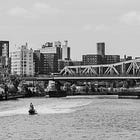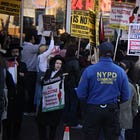On Amazon, land, and property in the Bronx
A worker's tour of Hunts Point
Amazon owns over 1 million square feet in the Bronx. My father tells me during a drive one Saturday in late July.
We are in the South Bronx, near the 60-acre Hunts Point Cooperative Market. My father has spent days and hours in this part of the borough, first as a truck driver in the 1990s and now as a sanitation worker.
He gives me a tour from outside his workplace and points out where he sees Amazon buying property and land. He sees how the Bronx’s buildings, parking garages, and empty lots are destroyed or sold and rebuilt, and the new structures that go up in their place, often attached to corporations.
We drive to three warehouses, including a 145,000-square-foot warehouse at Leggett Avenue and a 117,000-square-foot warehouse at 1300 Viele Avenue.
He remembers Hunts Points throughout the 90s.
I remember how big these streets felt, filled with trucks or mechanics, the McDonald’s, and the gas station. There were buildings, factories, and yards that were empty and yards that were packed with cars or random metals and parts. I remember the guard dog who lived in one of those yards that nobody seemed to own but who always seemed fed and the small kiddy pool we played in while my father worked on his truck.
We reminisce as he drives.
After Viele and Leggett, we go to a warehouse on Bruckner Boulevard at the former location of the Whitestone Multiplex Cinema. This warehouse is enormous. One area is filled with over 20 Prime trailers, and another is a parking lot filled with about 30 workers.
We drive into the lot and watch as each worker places Prime packages into different sedans and SUVs. They are all Amazon Flex drivers who, according to the company’s website, use their cars “to deliver packages for Amazon as a way of earning extra money to move you closer to your goals.”
Many are Dominican. My father stops one of the workers and asks him how much he makes. He doesn’t disclose his wage rate but said there is a tier system. He then directs us to the app for more information on open positions, hours, and pay. (According to the company website, they make between $18 and $25 an hour.)
You see Amazon’s presence throughout the Bronx. Packages left in building hallways. Signs about packages stolen from building hallways. Drivers ringing different bells to get into buildings and deliver hundreds of packages. Drivers working late into the evening. Rivian trucks double-parked down entire streets.
The multinational company opened its first New York City fulfillment center in September 2018 in Staten Island despite years of community resistance. Six years later, there are over 100 properties throughout New York, including lockers, parking lots, warehouses, and fulfillment centers.
In 2021, Catherine Chojnowski reported on the “Amazon-ification of Hunts Point” for The Hunts Point Express. She interviewed community members, including many who were unaware of how much land Amazon bought in their communities. Many expressed concerns over the corporation’s presence here.
She wrote:
The emergence of these facilities in the Bronx is part of Amazon’s effort to speed up deliveries by having “last mile” warehouses and lots strategically placed throughout the city. With the area’s proximity to Manhattan and its relatively cheap real estate, the South Bronx is proving to be an attractive location for Amazon and similar delivery ventures. South Bronx residents, however, are being subjected to increased traffic and worsening air quality in an area that already has one of the highest asthma rates in the nation.
Thousands are working across all these properties, in dangerous conditions, across the five boroughs.
Last year, a worker at a warehouse in Staten Island was anonymously interviewed about their experience. They described how difficult it is to work in the summers because the property gets so hot. Workers pass out or require medical attention. “They treat us like robots or slaves. You can’t sit down, you just stand up all the time. It’s painful. They come and talk to you if your break is a little too long. ‘Why haven’t you packed for more than 10 minutes?’”
Three years after the construction of the first warehouse, in 2021, the Amazon Labor Union, originally called the Congress of Essential Workers, was created in Staten Island after the firing of Chris Smalls, an employee who protested against the company’s COVID-19 safety measures.
In April 2022, the ALU was officially recognized as the first Amazon union.
Alongside our city’s crumbling infrastructure, our housing crisis, and rising food costs, corporations and institutions are chopping up the Bronx. We should not live in a world where companies have the resources to purchase land, lots, or whatever piece of property best serves corporate interests while the rest of us struggle for housing, electricity, or groceries.
As our neighborhoods continue to change rapidly—and as we continue to see the state repression of people fighting for our right to move freely within the physical spaces where we live and socialize—it’s important to understand which corporations and institutions control the very property the state protects.
Last year, I reported on the nurses’ strike at Montefiore Hospital for Hell Gate. I interviewed nurses about their working conditions and demands, including improved care for the hospital’s Bronx patients. During my research, I learned that in many of the neighborhoods where I live and work, Montefiore is one of the largest landlords. You walk up and down Bainbridge, Rochambeau, or Gun Hill Road, and you see property after property with the Montefiore flag, including residential and commercial properties.
The Bronx serves as cheap real estate for corporations and institutions that want to own and control as much land and property in the borough as possible. Amazon’s presence here is bigger than I realized, and this is because the Bronx is strategic for corporate interests. It’s the only one of the five boroughs connected to the continental United States, easily connected to our city’s airports and other parts of the state, and convenient for interstate transportation and goods—including a significant portion of our city’s food.
I’ve been thinking a lot about consumerism and the things we buy, and how often we purchase or feel the need to purchase.
Amazon makes it easy to give into the rush of online shopping and unboxing.
Companies like this also make life easier for workers who are tired physically, mentally, and spiritually. These companies also help those of us who might not be able to leave our homes as readily, those of us who are differently abled or can’t move or walk, and those of us who are elderly. Ordering online is convenient and cheap.
Yet our easy and cheap consumption violates our planet, in particular indigenous lands and their stewards. Our consumption is not separated from the ecological crisis, the exploitation and labor of much of the Global South, and the murder of Indigenous activists worldwide. As we collectively work to understand and see what is happening in our local communities, we must also understand how our actions and choices here affect the world.
At the end of my father’s tour, we talk about how often our city consumes, how easy it feels to order almost everything from Amazon, and how our consumption relates to the proliferation of Amazon properties across the boroughs.
Weeks later, I still think about the implications of corporations and institutions buying up land.
Weeks later, it still feels surreal to think about Amazon’s presence in the South Bronx, especially its presence around the markets that feed most of our city.
P.S.
Writer and comrade Shaira Chaer of Un Comunicado and other organizers are raising funds for Khalil Zeyara and his family in Gaza.
They write:
I have been in communication with Khalil Zeyara, and about a handful of us are putting our collective efforts into boosting his campaign and the campaigns of many other families in need. We have seen movement in Khalil’s campaign, but it is many tens of thousands away from the goal. Since October, Khalil has been actively posting and sharing stories and building his social media savvy, but it is not enough. He needs more people of conscience to step up and help support him. You can do that by donating to his GoFundMe, buying a print from my shop, or pooling funds with friends to maximize impact.
You can read more about this crowdfunding effort over at Un Comunicado. Please consider donating directly to Khalil’s GoFundMe. Any amount goes a long way!









This is so interesting and good